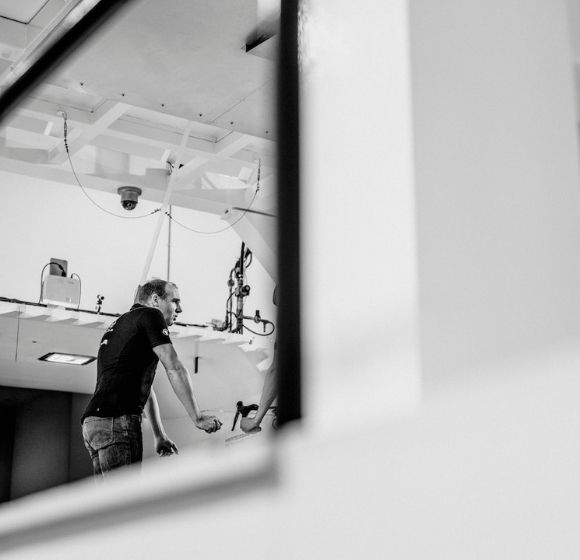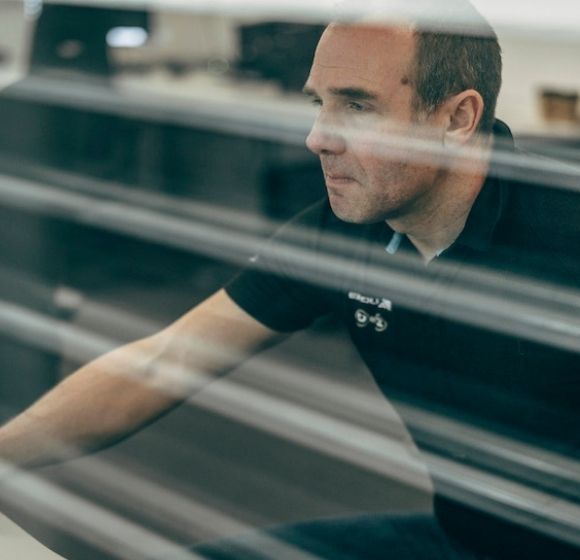
SIMON SMART
Endura's aerodynamics guru
It’s not possible simply to walk into the giant compound near Brackley, Northamptonshire that the Mercedes-AMG Petronas F1 team calls home.
A high-security environment, where names and vehicle registration numbers are recorded, passes issued, and instructions given on how to reach the area in which you're expected, it’s an 'invitation only' kind of place. If your name isn’t on the list, you certainly won’t be coming in.
“You have to specialise in what you’re good at, so it made sense to partner with Endura, who are so far down the road with textiles.”
Wind Tunnel One is at the far end of the compound from the main entrance, described by those who work there as “the tunnel of champions”. It is here that 50 per cent scale models of the cars propelled to the F1 drivers and constructors championships for the last three seasons are tested. And it is here that aerodynamicist Simon Smart has based his Drag2Zero business.
Endura and Drag2Zero have success to rival even that of Mercedes F1. Grand Tours and Hour Records have been achieved by Movistar Team with clothing whose aerodynamic blueprint was established in this highest of high-tech environments, and realised, with equal precision, some 350 miles away in Livingston.
“You have to specialise in what you’re good at,” Smart explains. “Ours is aerodynamics, so it made sense to partner with Endura, who are so far down the road with textiles, having built up an amazing resource in Scotland with their prototyping and manufacturing facility, which seems second to none.”
FROM FOUR WHEELS TO TWO
Smart knew from a child what he wanted to do with his life. Working at the pinnacle of motorsport was, he says, his "mission". The intoxicating mix of technical excellence and thrilling speed planted a seed of ambition that would flower at the Jaguar and Red Bull Racing F1 teams.
Why then, with his life’s goal achieved, and leading a team of aerodynamicists at Red Bull Racing, would Smart turn from F1 to cycling? It’s a career move whose success can be judged by his client list, even if some of his former colleagues struggle to understand his decision. Perhaps they have a point. Isn’t the automotive industry’s showcase the pinnacle of aerodynamic engineering?
“The bike industry was quite a long way behind Formula One, but as we advance, we’re definitely getting into incremental gains and diminishing returns.”
Smart shrugs. During his time at Red Bull Racing, he had been bitten by the time-trialing bug, even going so far as to set up a wind tunnel off-site, in Swindon, to analyse riding positions. But this is not merely a case of grass being greener.
Smart had grown to feel that, in Formula One, the engineer’s instinct had been supplanted by science; that gut feeling had been pushed out by numbers, even if a focus on data had once been his modus operandi. Cycling, by contrast, operating with vastly reduced resources, and representing a comparatively “immature” field of study for aerodynamics, offered greater satisfaction.
A cyclist’s clothing now offers the greatest potential to the ambitious aerodynamicist. Smart’s work with Endura can accurately be described as leading edge. The Brackley-Livingston axis has existed for three years, and the results speak for themselves. Last year alone, Movistar Team riders won the time-trial championships of Spain, Portugal and Great Britain. It is the British champion, Alex Dowsett, who is at work in Wind Tunnel One on the day of our visit to Brackley.





BLUFF BODIES AND MANNEQUINS
The budgets might not compare, but perhaps cycling is a no less demanding field than F1, after all. The wheels are the “messiest” area of the car, in aerodynamic terms, Smart explains, and a bicycle is “one big wheel”.
“In that respect, it really is very challenging. When you get flow separation, it’s just chaotic. The forces we’re dealing with are tiny. Probably one of the biggest challenges is realising how little force you have to play with.
“When you get flow separation, it’s just chaotic. The forces we’re dealing with are tiny. The instrumentation needs to be very accurate.”
“As a system, you’re seeing 2,500g of drag. In F1, you’re concentrating more on downforce, but with a model, you’re maybe seeing 150kg, rather than 2.5kg, so the level of error is much smaller. The instrumentation needs to be very accurate.”
And how. The low platform to which Dowsett’s machine is attached is no mere bike stand, but a supremely accurate weighing scale, one capable also of removing the oscillation of pedal stroke from its readings. Smart talks of “signal to noise” ratio, and the necessity of reducing all possible dissonance to focus entirely on the aerodynamicist’s unchanging goal of reducing a rider’s CdA, that cold calculation of drag coefficient multiplied by frontal area.
Air flow is as complex a medium as might be imagined, especially outdoors. The separation of air as it moves around the human form (“a bluff body”, in Smart’s language) and controlling the point at which it reunites is the focus of his calculation and instinct. When Dowsett is away racing, Smart deploys a mannequin, the result of a supremely accurate scan of bicycle and rider, made at the Human Solutions laboratory in Kaiserslautern, Germany, and organised by Endura.
LAB COATS, AERO GAINS AND LOW-HANGING FRUIT
The “low-hanging fruit” of frames and wheels has long since been picked. Smart describes both markets as “mature”. A 10 per cent gain in frame optimisation, still a significant number, might nowadays yield a reduction of only three watts, where 10 years ago, savings of 20 watts were not unheard of, he says.
Clothing, however, remains fertile ground for aerodynamic enhancement, even if the variables of human form, riding position, fabrics and myriad other concerns make it among the most complex of fields.
“As well as being a great cyclist, Alex has that extra level of understanding of the technology and set-up, which some cyclists don’t see as a big part of the sport.”
“There are other considerations as well, which makes it very challenging: the stretch, the breathability, the fabrication of the products, the printing. There are a lot of different things that you have to consider,” Smart explains.
“Hopefully, I have some understanding of what’s going on, and I’m not a man in a white lab coat who’s totally unreasonable. I do ‘get’ cycling and realise that you need to be able to breathe in the clothing and move in it.”


CONDUCTING THE ORCHESTRA
Smart does not lack for accomplices. Many of the world’s best time-trialists have sought his insights, but it is Dowsett and another Endura sponsored athlete, Matt Bottrill, with whom he has made some of his most significant advances.
“It was interesting to listen to Alex today,” Smart says, at the end of a highly productive session in which a double digit wattage saving has been achieved by changes to his riding position. “I really think that all the successful time-trialists have that extra level of appreciation for the technical side of the sport, and with his dad being an ex-racing driver, you can see where he gets it from.
“Hopefully, I have some understanding of what’s going on with cycling, and I’m not a man in a white lab coat who’s totally unreasonable.”
“As well as being a great cyclist, Alex has that extra level of understanding of the technology and set-up, which some cyclists don’t see as a big part of the sport. For the time-trial, it has to be. All the great time-trialists independently appreciate the science of reducing drag, and Alex is certainly one of them.”
Dowsett is a fascinating mixture of the relaxed and focussed. He is calm, friendly and good company in the long period before testing, but once inside the tunnel, is all business. It’s an attitude entirely complementary to Smart’s. We had been asked beforehand not to pose questions during those crucial moments when Smart was fully concentrated on the task at hand, but this is immediately obvious from his body language.
Benedict Campbell’s photographs capture a man whose thoughts seem to be travelling beyond the data on the screen. His two assistants, clad in the muted grey of Mercedes F1, implement Smart’s instructions with the professionalism one might expect from employees of motorsport’s leading constructor. There is little doubt, however, who is in control. If the tunnel and its staff are an orchestra, then Smart is the conductor.
INCREMENTAL GAINS AND DIMINISHING RETURNS
The science of extracting further gains from clothing is becoming ever more sophisticated. Smart has seen CdA values plummet as aero has taken hold since he started testing cyclists in 2007, and he predicts an era of still greater refinement as clothing becomes more optimised. For the aerodynamicist, this is where things become interesting.
“The bike industry was quite a long way behind Formula One,” he says, “but as we advance, we’re definitely getting into incremental gains and diminishing returns.”
“All the great time-trialists independently appreciate the science of reducing drag, and Alex is certainly one of them.”
Endura and Drag2Zero are experimenting with new ways to manipulate air flow by optimising fabrics. More than that, we cannot say. Yet. Given the success already achieved by the partnership, expectations will be high, but the ambience inside Wind Tunnel One could not be calmer. Smart, Dowsett and Bottrill will continue their work, reporting their findings to Endura, who will add their own expertise to create faster, more slippery’ garments than their competitors.
The future is, as they say, bright. In an era of diminishing returns, step change may be required to gain significant advantage over the competition. Endura and Drag2Zero have made such advances a stock in trade, garnering some of the biggest prizes in professional cycling in the process. Watch this space.
FOOTNOTES Words by Timothy John. Images by Sean Hardy Brackley, United Kingdom© 2021 ENDURA